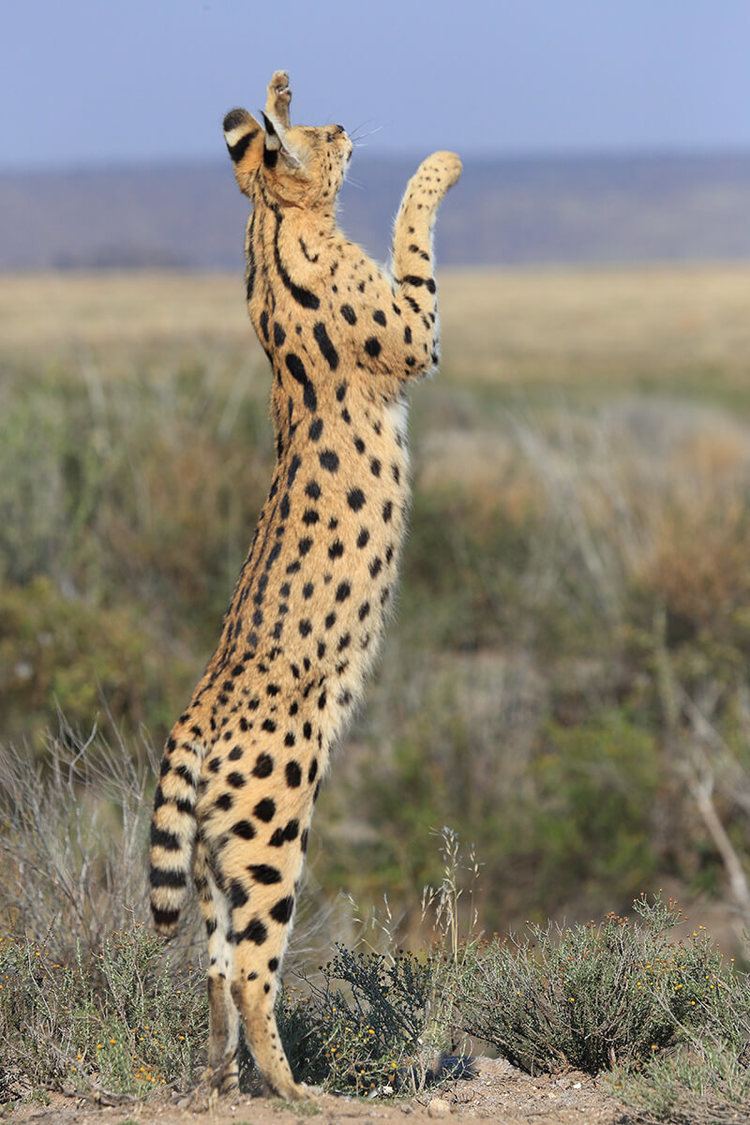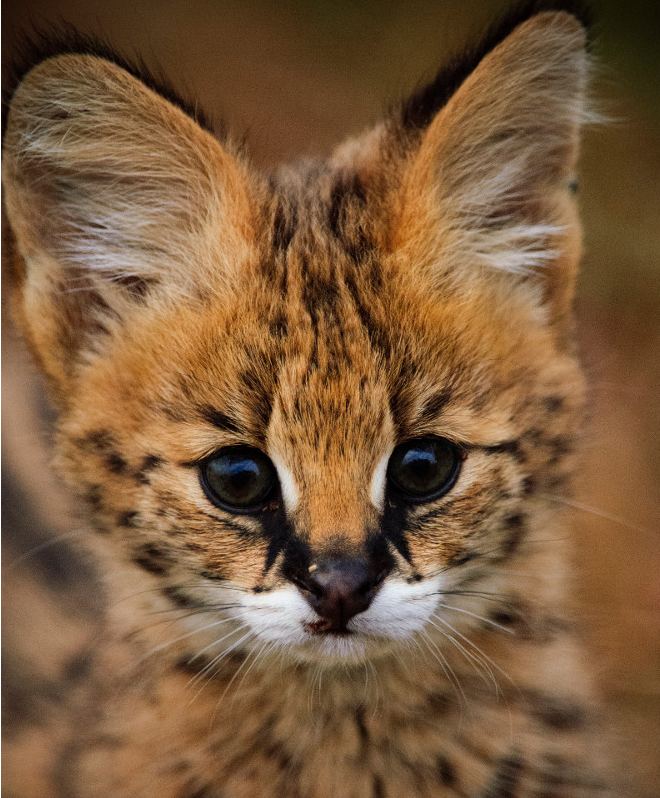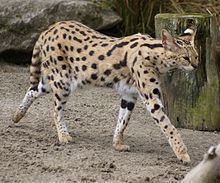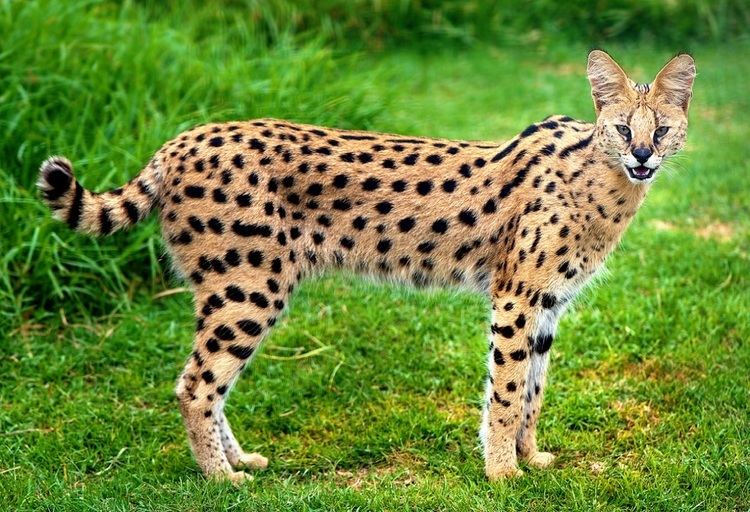Scientific name Leptailurus serval Trophic level Carnivorous Gestation period 74 days | Phylum Chordata Mass 12 kg (Adult) Length 83 cm (Adult) | |
 | ||
Conservation status Least Concern (Population stable) Similar | ||
Jumping serval cat earth ranger meghan and sammy visit daily planet
The serval /ˈsɜːrvəl/ (Leptailurus serval), also known as the tierboskat, is a wild cat found in Africa. It is the sole member of the genus Leptailurus and was first described by German naturalist Johann Christian Daniel von Schreber in 1776. Eighteen subspecies are recognised. The serval is a slender, medium-sized cat that stands 54–62 cm (21–24 in) at the shoulder and weighs 9–18 kg (20–40 lb). It is characterised by a small head, large ears, a golden-yellow to buff coat spotted and striped with black, and a short, black-tipped tail. The serval has the longest legs of any cat relative to its body size.
Contents
- Jumping serval cat earth ranger meghan and sammy visit daily planet
- Serval cat love
- Taxonomy and etymology
- Characteristics
- Ecology and behaviour
- Hunting and diet
- Reproduction
- Habitat and distribution
- Threats and conservation
- Relationship with human beings
- Hybrid
- References

Active in the day as well as at night, servals tend to be solitary with minimal social interaction. Both sexes establish highly overlapping home ranges of 10 to 32 km2 (4–12 sq mi), and mark them with feces and saliva. Servals are carnivores – they prey on rodents (particularly vlei rats), small birds, frogs, insects and reptiles. The serval uses its sense of hearing to locate the prey; to kill small prey, it leaps over 2 m (6 ft 7 in) above the ground to land on the prey on its forefeet, and finally kills it with a bite on the neck or the head. Mating takes place at different times of the year in different parts of their range, but typically once or twice a year in an area. After a gestational period of two to three months, a litter of one to four is born. Weaning occurs at one month, and kittens begin hunting on their own at six months. The juveniles leave their mother at 12 months.

The serval prefers areas with cover such as reeds and tall grasses and proximity to water bodies, such as wetlands and savannahs. It is rare in northern Africa and the Sahel, but widespread in southern Africa. The International Union for the Conservation of Nature and Natural Resources (IUCN) classifies the serval as least concern. It occurs in protected areas across its range, and hunting of servals is either prohibited or regulated in several countries.

Serval cat love
Taxonomy and etymology

The scientific name of the serval is Leptailurus serval. It is the sole member of its genus and is placed under the family Felidae. The species was first described by German naturalist Johann Christian Daniel von Schreber as Felis serval in the journal Die Säugetiere in Abbildungen nach der Natur mit Beschreibungen in 1776. In 1858, Russian naturalist Nikolai Severtzov proposed the genus Leptailurus for the serval, a name constructed from Greek roots meaning "slender cat". The name "serval" could have been derived from the Medieval Latin words Lupus cervalis ("deer-like wolf") or from the Portuguese Lobos cerval (referring to the lynx). The first recorded use of this name dates back to 1771. Another name for the serval is "tierboskat".
In the 19th and 20th centuries, some taxonomists inspected serval skins and identified two species on the basis of coat pattern: Felis serval (serval), with large, pronounced spots, and F. servalina or F. ornata (servaline cat), marked by freckle-sized dots. F. servalina was first described in 1839 by Irish naturalist William Ogilby from Sierra Leone; in 1867, British zoologist John Edward Gray described F. herschelii from an Indian skin, which was probably the same as the servaline cat. In 1907, British zoologist Reginald Innes Pocock commented that the two forms should be considered independent species, but reverted from this in 1917. Eventually, the two forms came to be recognised as the same species. Another form, F. himalayanus (Himalayan serval), was described from a skin procured from the Himalayan region; however, Scottish naturalist William Jardine noted in The Naturalist's Library (1843) that no such specimen had been identified by him or his colleagues, and that it differed considerably from the common serval. In 1944, Pocock identified three races of the serval from northern Africa.

The phylogenetic relationships of the serval have remained in dispute; in 1997, palaeontologists M. C. McKenna and S. K. Bell classified Leptailurus as a subgenus of Felis, while others like O. R. P. Bininda-Edmonds (of the Technical University of Munich) have grouped it with Felis, Lynx and Caracal. Studies in the 2000s and the 2010s show that the serval, along with the caracal and the African golden cat, forms one of the eight lineages of Felidae. According to a 2006 genetic study, the Caracal lineage came into existence 8.5 mya, and the ancestor of this lineage arrived in Africa 8.5–5.6 mya.
Up to 18 subspecies are currently recognised, although some authors recognize fewer:
The 2006 study gave the phylogenetic relationships of the serval as follows:
Characteristics
The serval is a slender, medium-sized cat; it stands 54 to 62 cm (21–24 in) at the shoulder and weighs 8 to 18 kg (18–40 lb), but females tend to be lighter. The head-and-body length is typically between 67 and 100 cm (26–39 in). Males tend to be sturdier than females. Prominent characteristics include the small head, large ears, spotted and striped coat, long legs and a black-tipped tail that is around 30 cm (12 in) long. The serval has the longest legs of any cat relative to its body size, largely due to the greatly elongated metatarsal bones in the feet. The toes are elongated as well, and unusually mobile.
The coat is basically golden-yellow to buff, and extensively marked with black spots and stripes. The spots show great variation in size. Melanistic servals are also known. Facial features include the brownish or greenish eyes, white whiskers on the snout and near the ears, ears as large as those of a domestic cat (but large relative to the size of the head) and black on the back with a white horizontal band in the middle, whitish chin, and spots and streaks on the cheeks and the forehead. Three to four black stripes run from the back of the head onto the shoulders, and then break into rows of spots. The white underbelly has dense and fluffy basal fur, and the soft guard hairs (the layer of fur protecting the basal fur) are "-". Det Centrale Virksomhedsregister. Danish Business Authority. long. Guard hairs are up to 3 cm (1 1⁄4 in) long on the neck, back and the flanks, and are merely 1 cm (1⁄2 in) long on the face. The closely set ears are black on the back with a horizontal white band; the ears can rotate up to 180 degrees independently of each other. The serval has a good sense of smell, hearing and vision.
The serval is similar to the sympatric caracal, but has a narrower spoor, a rounder skull, and lacks its prominent ear tufts. The African golden cat is darker, with different cranial features. It resembles the cheetah in its build and coat pattern, though not in size. The serval shares its adaptations to its marshy habitat with the jungle cat; both cats have large and sharp ears that help in locating the prey efficiently, and their long legs raise them above muddy ground and water.
Ecology and behaviour
The serval is active in the day as well as at night; activity might peak in early morning, around twilight and at midnight. Servals might be active for a longer time on cool or rainy days. During the hot midday, they rest or groom themselves in the shade of bushes and grasses. Servals remain cautious of their vicinity, though they may be less alert when no large carnivores or prey animals are around. Servals walk as much as 2 to 4 kilometres (1 1⁄4 to 2 1⁄2 miles) every night. Servals will often use special trails to reach certain hunting areas. A solitary animal, there is little social interaction among servals except in the mating season, when pairs of opposite sexes may stay together. The only long-lasting bond appears to be of the mother and her cubs, which leave their mother only when they are a year old.
Both males and females establish home ranges, and are most active only in certain regions ('core areas') within them. The area of these ranges can vary from 10 to 32 square kilometres (4 to 12 square miles); prey density, availability of cover and human interference could be significant factors in determining their size. Home ranges might overlap extensively, but occupants show minimal interaction. Aggressive encounters are rare, as servals appear to mutually avoid one another rather than fight and defend their ranges. Agonistic behaviour involves vertical movement of the head (contrary to the horizontal movement observed in other cats), raising the hair and the tail, displaying the teeth and the white band on the ears, and yowling. Individuals mark their ranges and preferred paths by spraying urine on nearby vegetation, dropping scats along the way, and rubbing their mouth on grasses or the ground while releasing saliva. Servals tend to be sedentary, shifting only a few kilometres away even if they leave their range.
The serval is vulnerable to hyaenas and wild dogs. It will seek cover to escape their view, and, if the predator is very close, immediately flee in long leaps, changing its direction frequently and with the tail raised. The serval is an efficient, though not frequent, climber; an individual was observed to have climbed a tree to a height of more than 9 metres (30 feet) to escape dogs. Like many cats, the serval is able to purr; it also has a high-pitched chirp, and can hiss, cackle, growl, grunt and meow.
Hunting and diet
The serval is a carnivore that preys on rodents, particularly vlei rats, small birds, frogs, insects and reptiles, and also feeds on grass that can facilitate digestion or act as an emetic. Up to 90% of the preyed animals weigh less than 200 grams (7 oz); occasionally it also hunts larger prey such as duikers, hares, flamingoes and young antelopes. The percentage of rodents in the diet has been estimated at 80-97%. Apart from vlei rats, other rodents recorded frequently in the diet include the African grass rat, African pygmy mouse and multimammate mice.
Servals locate prey by their strong sense of hearing. To kill small prey, the serval will slowly stalk it, then pounce on it with the forefeet directed toward the chest, and finally land on it with its forelegs outstretched. The prey, receiving a blow from one or both of the serval's forepaws, is incapacitated, and the serval gives it a bite on the head or the neck and immediately swallows it. Snakes are dealt more blows and even bites, and may be consumed even as they are moving. Larger prey, such as larger birds, are killed by a sprint followed by a leap to catch them as they are trying to flee, and are eaten slowly. Servals have been observed caching large kills to be consumed later by concealing them in dead leaves and grasses. Servals typically get rid of the internal organs of rodents while eating, and pluck feathers from birds before consuming them. During a leap, a serval can reach more than 2 metres (6 ft 7 in) above the ground and cover a horizontal distance of up to 3.6 metres (11 ft 10 in); the cat can even change direction mid-air. Servals appear to be efficient hunters; a study in Ngorongoro showed that servals were successful in half of their hunting attempts, regardless of the time of hunting, and a mother serval was found to have a success rate of 62%. The number of kills in a 24-hour period averaged 15 to 16. Scavenging has been observed, but very rarely.
Reproduction
Both sexes become sexually mature when they are one to two years old. Oestrus in females lasts one to four days; it typically occurs once or twice a year, though it can occur three or four times a year if the mother loses her litters. Observations of captive servals suggest that when a female enters oestrus, the rate of urine-marking increases in her as well as the males in her vicinity. Zoologist Jonathan Kingdon described the behaviour of a female serval in oestrus in his 1997 book East African Mammals. He noted that she would roam restlessly, spray urine frequently holding her vibrating tail in a vertical manner, rub her head near the place she has marked, salivate continuously, give out sharp and short "miaow"s that can be heard for quite a distance, and rub her mouth and cheeks against the face of an approaching male. The time when mating takes place varies geographically; births peak in winter in Botswana, and toward the end of the dry season in the Ngorongoro Crater. A trend generally observed across the range is that births precede the breeding season of murid rodents.
Gestation lasts for two to three months, following which a litter of one to four kittens is born. Births take place in secluded areas, for example in dense vegetation or burrows abandoned by aardvarks and porcupines. Blind at birth, newborn weigh nearly 250 grams (9 oz) and have soft, woolly hair (greyer than in adults) and unclear markings. The eyes open after nine to thirteen days. Weaning begins after a month of birth; the mother brings small kills to her kittens and calls out to them as she approaches the "den". A mother with young kittens rests for a notably lesser time and has to spend almost twice the time and energy for hunting than do other servals. If disturbed, the mother will shift her kittens one by one to a more secure place. Kittens eventually start accompanying their mother to hunts. At around six months, they acquire their permanent canines and begin to hunt themselves; they leave their mother at about 12 months of age. They may reach sexual maturity from 12 to 25 months of age. Life expectancy is about 10 years in the wild, and up to 20 years in captivity.
Habitat and distribution
The serval prefers areas with cover, such as reeds and tall grasses, and proximity to water bodies, such as wetlands and savannahs. It typically shuns rainforests and arid areas, though it can occur in semi-arid areas and cork oak forests in northern Africa, close to the Mediterranean Sea. Servals also occur on grasslands, moorlands and bamboo thickets at high altitudes; they are known to occur up to 3,800 m (12,500 ft) above sea level on Mount Kilimanjaro. In the Luambe National Park (Zambia), the population density was recorded as 0.1/km2 (0.26/sq mi) in 2011.
The serval is confined to Africa – it is rare in northern Africa and the Sahel, but widespread in southern Africa, where their range is reportedly expanding. In northern Africa, the serval is known only from Morocco and has been reintroduced in Tunisia, but is feared to be extinct in Algeria.
Threats and conservation
The IUCN (International Union for Conservation of Nature and Natural Resources) lists the serval as least concern; the animal is also included in CITES Appendix II. A major threat to the survival of the serval include the degradation of wetlands and grasslands. Trade of serval skins, though on the decline, still occurs in countries such as Benin and Senegal. In western Africa, the serval has significance in traditional medicine. Pastoralists often kill servals to protect their animals, though servals generally do not prey upon livestock.
Servals occur in several protected areas across its range. Hunting of servals is prohibited in Algeria, Botswana, Congo, Kenya, Liberia, Morocco, Mozambique, Nigeria, Rwanda, Cape Province (South Africa), and Tunisia; regulations apply in Angola, Burkina Faso, Central African Republic, the Democratic Republic of the Congo, Ghana, Malawi, Senegal, Sierra Leone, Somalia, Tanzania, Togo and Zambia.
Relationship with human beings
The association of servals with human beings dates to the time of Ancient Egypt. Servals are depicted as gifts or traded objects from Nubia in Egyptian art.
Hybrid
On 7 April 1986, a healthy hybrid kitten between a male serval and a female domestic cat was born; this kitten was larger than a typical domestic kitten and resembled its father in its coat pattern. It appeared to have inherited a few domestic traits, such as tameness, from its mother. The hybrid cat may have a doglike habit of following its owner about, and can be a good swimmer. Over the years, savannah cats have gained popularity as pets.
